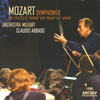Mozart Symphonies Nos 29, 33, 35 'Haffner', 38 'Prague', 41 'Jupiter'
Abbado happy to immerse himself in Mozart at last: this is a high-class set
View record and artist detailsRecord and Artist Details
Composer or Director: Wolfgang Amadeus Mozart
Genre:
Orchestral
Label: Archiv
Magazine Review Date: 13/2008
Media Format: CD or Download
Media Runtime: 0
Mastering:
Stereo
DDD
Catalogue Number: 4777598

Tracks:
| Composition | Artist Credit |
|---|---|
| Symphony No. 29 |
Wolfgang Amadeus Mozart, Composer
Claudio Abbado, Conductor Mozart Orchestra Wolfgang Amadeus Mozart, Composer |
| Symphony No. 33 |
Wolfgang Amadeus Mozart, Composer
Claudio Abbado, Conductor Mozart Orchestra Wolfgang Amadeus Mozart, Composer |
| Symphony No. 35, "Haffner" |
Wolfgang Amadeus Mozart, Composer
Claudio Abbado, Conductor Mozart Orchestra Wolfgang Amadeus Mozart, Composer |
| Symphony No. 38, "Prague" |
Wolfgang Amadeus Mozart, Composer
Claudio Abbado, Conductor Mozart Orchestra Wolfgang Amadeus Mozart, Composer |
| Symphony No. 41, "Jupiter" |
Wolfgang Amadeus Mozart, Composer
Claudio Abbado, Conductor Mozart Orchestra Wolfgang Amadeus Mozart, Composer |
Author: Lindsay Kemp
There seems little doubt that Abbado has been influenced by period performance in his overall approach – the Orchestra Mozart go light on the vibrato, use hard timpani sticks and occasionally toss in the odd bit of playful ornamentation – but that is really only a small part of the story. These performances are above all triumphs of experience, innate musicality and understanding, meticulous yet clear thinking, and that quality of which Abbado has spoken most highly in recent years, the art of listening. Only by using his ears could Abbado have so keenly assessed the individual personalities of these superb works and arrived at interpretations which seem so unquestionably right, so lacking in preconceived ideas, so beautifully classical and yet so free and personal in the best of senses.
Some general characteristics can be identified: Abbado plays Mozart with “soft hands”, not allowing even the loudest timpani-driven passages to descend into noise or clatter; he does not allow himself to be hurried, yet never appears slow or lacking in momentum; and every movement, paragraph and phrase is shaped with a compelling combination of rhetorical precision and utter naturalness.
Feel you need to know more? Well, let us take the symphonies in the order in which they appear. Abbado marks out the ground in No 35 with an exquisitely shaped first-movement exposition, full of conversational eloquence and ever-changing dynamics. The slow movement is brisk but dainty, its second subject so quiet it almost disappears; the Minuet pauses comfortably at the end of its first phrase and relaxes into its Trio; and the finale generates gutsy velocity without yielding like a hot-head to Mozart’s suggestion to play it “as fast as possible”.
No 29 revels in detail: repeated viola notes stab at the texture in the first movement, and, not for the first time in this set, a gracious diminuendo subsides gently to the moment of recapitulation. The luminous Andante features the silkiest of muted strings and the most diaphanous of pianissimos, seeming almost to want to imitate the unearthly timbre of the glass harmonica. The Minuet includes a markedly slowed Trio, and the finale jumps in eagerly, the violins biting into the semiquavers at the ends of the rondo theme’s first two phrases.
No 33 is a marvel of momentum and buoyancy, the first movement suavely swinging like the most aristocratic Ländler you have ever seen, the Minuet charmingly light on its feet, and the finale avoiding all hints of clumsiness as it bustles on its way.
Abbado takes all the available repeats in No 38, turning its first movement into a Mozartian giant at just under 18 minutes. The slow introduction is masterfully drawn, conjuring its Don Giovanni-like foreboding not, as some have done, with thunderous timpani thwacks but rather suggesting a deeper level of menace by the way things are held in check. After this, the main body of the movement is grand and muscular, but softens into another kindly let-down into the recapitulation. The Andante of the Prague is a hard one in terms of tempo but Abbado is probably the most successful yet at catching its two-in-a-bar 6/8 lilt in a perfectly judged pulse.
The Jupiter is a fitting end to the set. Abbado’s approach in the first movement is loving, teasing out the opening question-and-answer figures and giving each of the rising phrases which come later in the cellos and basses a yearning squeeze. No less amorous is the mood of the slow movement, where feathery caresses from the violins and occasional night-noises conjure an atmosphere of warmth and stillness, while in the wheeling Minuet Abbado relishes the mounting ardour of the wave of falling chromatic lines in its second half. The finale dispels any thoughts of self-indulgence, however, evoking all the confident energy and excitement Mozart must have felt in composing it, and teasing out its wondrous contrapuntal textures with exemplary clarity.
These five symphonies were recorded live at concerts in Italy, and there are a few very minor untidinesses of ensemble which the recording does little to hide, though its analytical dryness may be helpful in other ways. To the ear, however, it is a little too close for comfort. But do not let that discourage you; these Mozart performances are in the very highest class.
Discover the world's largest classical music catalogue with Presto Music.

Gramophone Digital Club
- Digital Edition
- Digital Archive
- Reviews Database
- Full website access
From £8.75 / month
Subscribe
Gramophone Full Club
- Print Edition
- Digital Edition
- Digital Archive
- Reviews Database
- Full website access
From £11.00 / month
Subscribe
If you are a library, university or other organisation that would be interested in an institutional subscription to Gramophone please click here for further information.




